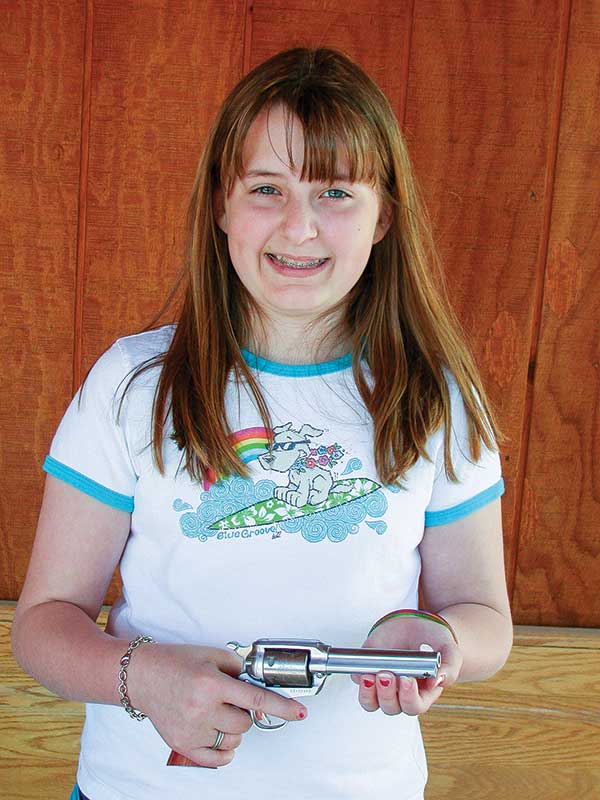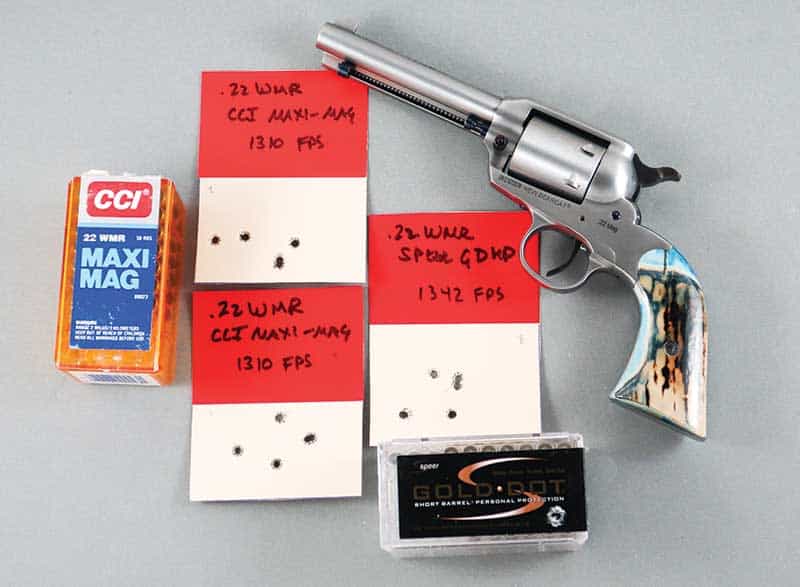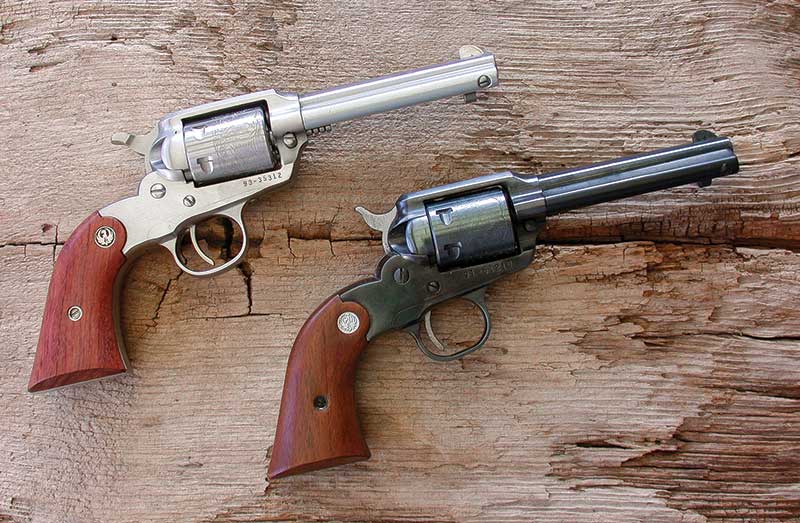TYLER GUN WORKS .22 MAGNUM RUGER BEARCAT
BUILDING MEMORIES PAST AND FUTURE
WRITTEN BY JOHN TAFFIN
Bill Ruger apparently always looked back into history to find inspiration for many of his projects. In 1958, probably after studying the Remington .31 cap-n-ball pocket pistol, Bill did the same thing as he had done with the Single-Six. He brought out an up-to-date .22 version and called it — this also came from history, cars not guns this time — the “Bearcat” after the Stutz Bearcat automobile. It was fitting such a beautiful car would lend its name to Ruger’s second .22 revolver.
John presented his youngest granddaughter with a Bearcat when she was just a young shooter; she is now a Doctor of Pharmacy.
Spanning The Years
Bearcats have had a special significance in our family for generations. By the 1970s my son was 10 years old and ready for his very own first revolver. Since my first revolver was a .22 Ruger Single-Six in the mid-1950s, I knew it had to be a .22, it had to be a single action and it had to be a Ruger.
The bargain we struck was I would pay half if he would save up the other half. It took him quite a few odd jobs to come up with his part but on his 10th birthday, we bought a brand-new Ruger Bearcat. The shop owner threw in a box of .22s, I fashioned a belt and holster, a friend made custom grips, and another generation was ready to enter the satisfying world of sixgunning. He still has the Bearcat.
My granddaughter, his youngest, also has a Bearcat as her first firearm. I presented her with a Ruger stainless steel, round-butted Shopkeeper’s Models from Lipsey’s when she was 10. She is now a pharmacist. Diamond Dot also has a Super Bearcat and my old Bearcat is well-worn but still shoots the way we expect any Ruger to do.
In 2014 Ruger introduced the adjustable-sighted Bearcat. Since I had been asking for one for so long, Ruger presented me with one. It has now been fitted with custom grips and put away for my first great-grandchild when she reaches shooting age.
Design Tweaks
Unlike the Single-Six, the Bearcat featured a one-piece grip frame/mainframe combination, originally cast from aluminum alloy, which later was replaced with steel. The Bearcat has especially been popular with those who must consider every ounce important — backpackers, hikers, fishermen, smokejumpers, anyone who wanted a lightweight .22 to carry unobtrusively.
When Ruger switched to New Model production with a transfer bar safety in both the Single-Six and Blackhawk series, they elected to drop the Bearcat rather than add a transfer bar. The Bearcat was then resurrected in 1993 complete with a transfer bar safety, however, unlike the Single-Six and the Blackhawk, the Bearcat features a half-cock notch on the hammer.
The Bearcat is rarely seen in holsters. Instead it can be found in backpacks, fishing tackle boxes, pockets, anywhere a small space will accept this diminutive .22. All Ruger Bearcats made since 1958 have been chambered in .22. However, about 1,000 were made with an auxiliary .22 Winchester Magnum Rimfire cylinder. These are now very rare and if one wants a .22 Magnum Bearcat it is strictly a custom proposition. Enter Bobby Tyler of Tyler Gun Works in Friona, Texas. Bobby is converting current production Bearcats to .22 Magnum and one of his customers for one of these exceptionally handy and potent Kit Guns allowed me the privilege of testing it first.
Tyler Test
Starting with a stainless-steel .22 Long Rifle Bearcat, Bobby maintains the factory barrel and re-chambers the factory cylinder to .22 WMR. After considerable experimenting and re-barreling several with custom barrels, he found accuracy using the original parts was just as good as building a custom cylinder and custom barrel. This saves a considerable amount of money.
In addition to converting the cylinder the action is tuned and tightened along with a smoothing of the trigger. With the action work and trigger job, this little Bearcat also receives the accuracy package consisting of adjusting the barrel/cylinder gap, re-crowning the barrel and aligning the cylinder as perfectly as possible to the forcing cone. Bobby says he will re-barrel and re-cylinder when asked to do so, however he finds it is not necessary to replace the originals. He also offers this conversion with two cylinders chambered in .22 LR and .22 Magnum.
The top of the barrel is now marked “Tyler Gun Works Friona TX” in two lines and the left side of the frame says “.22 Mag.” The gun itself is all stainless except for the trigger and hammer, which are case-colored while the cylinder pin, ejector rod head, and all screws are nitre-blue. The cylinder pin is from Belt Mountain.
All of the Old Model Rugers — Single-Six to Blackhawk to Super Blackhawk — produced from 1953 to 1972 are known as “Three-Screw Models” due to the three screws in the side of the frame. With the introduction of the New Model the three screws were replaced by two pins. The New Bearcat is not only unique in the fact it has both a transfer bar and half-cock notch, it also has two screws instead of two pins.
Beautiful Bearcat
With its stainless-steel finish matched with blued screws, this is quite an attractive little .22 Magnum. So what does one do to finish the project and make it especially eye appealing? For Bobby, the answer was found in the grips, which I, as a grip connoisseur, find especially attractive. Bill Ruger often reached back in history for inspiration and to name his firearms, however Bobby went back even further and chose woolly mammoth ivory for the grips. This particular ivory was buried in soil that gave it a blue cast, resulting in a uniquely beautiful set of grips.
This Tyler Gun Works .22 Magnum was fired with a variety of factory .22 Winchester Magnum Rimfire loads at a distance of 12 yards. Some of the best shooting loads were from Armscor with a muzzle velocity of 1,260 fps and groups of 1″ or less; while Remington Accutip, 1,427 fps; Winchester JHP, 1,289 fps; CCI Maxi-Mag, 1,310 fps; and Speer GDHP at 1.342 fps. All group just slightly over 1″ for five shots at 12 yards.
This is a grand little sixgun that increases muzzle velocity significantly over the .22 Long Rifle. It is not going to be easy to send it back.





